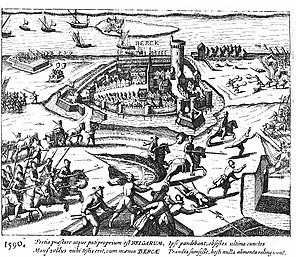1590 siege
Caribbean and South America Atlantic European waters Low Countries and Germany France Ireland
The siege of Rheinberg 1586–1590 , also known as the capture of Rheinberg of 1590 , took place at the strategic Cologne enclave of Rheinberg (present-day North Rhine-Westphalia , Germany ), one of the principal crossing-points over the Rhine on the stretch between the Electorate of Cologne and the Dutch border,[ 3] Eighty Years' War , the Cologne War , and the Anglo-Spanish War (1585–1604) .[ 1] [ 2] Alexander Farnese, Duke of Parma (Spanish : Alejandro Farnesio) , commander-in-chief of the Spanish army, sent a substantial force, under Peter Ernst, Count of Mansfeld , to besiege Rheinberg.[ 2] [ 4] Maarten Schenck van Nydeggen (until his death at the Assault on Nijmegen on 10 August 1589),[ 5] Francis Vere (from 1590), to relieve the fortress city, the Protestant garrison finally surrendered to the Spaniards on 3 February 1590.[ 5] [ 6] [ 7]
On 19 August 1597 the Dutch army led by Maurice of Nassau captured Rheinberg for the States in his successful campaign of 1597,[ 8] Army of Flanders led by Don Francisco de Mendoza retook the strategic place, forcing the garrison to surrender .[ 9]
See also
Notes
^ a b Wilson p.210
^ a b c Israel p.29
^ He (Duke of Parma) then moved north to capture Rheinberg in February 1590, a Cologne enclave that provided access across the Rhine and facilitated the subsequent campaigns to outflank the Dutch Republic from the east. Wilson p.210^ Hennes pp.177–179
^ a b Brodek pp.400–401
^ It was the occupation of Rheinberg by Spanish troops in that month which marked the inauguration of the fixed network of Spanish garrisons in north-west Germany. Israel p.29^ Luc Duerloo p.46
^ Israel pp.29–30
^ Juan Valera p.521
References
Hennes, Johann Heinrich. Der Kampf um das Erzstift Köln zur Zeit der Kurfürsten. Köln: DuMont-Schauberg. 1878. (in German)
Benians, Ernest Alfred, et al. The Cambridge Modern History. New York: MacMillan. 1905.
Hamish Wilson, Peter. The Thirty Years War: Europe's Tragedy. First published 2009 by Penguin Group. ISBN 978-0-674-03634-5
Brodek, Theodor V. Socio-Political Realities of the Holy Roman Empire . Journal of Interdisciplinary History. 1971.
Luc Duerloo. Dynasty and Piety: Archduke Albert (1598–1621) and Habsburg Political Culture in an Age of Religious Wars. MPG Books Group. UK.
Parker, Geoffrey. The Army of Flanders and the Spanish Road, 1567–1659. Cambridge: Cambridge University Press. 2004. ISBN 978-0521543927
Juan Valera. Homenaje a Menéndez Pelayo. Estudios de Erudición Española .(in Spanish)
Jonathan I. Israel. Conflicts of Empires: Spain, the Low Countries and the Struggle for World Supremacy 1585–1713. London. 1997. ISBN 1-85285-161-9
External links
